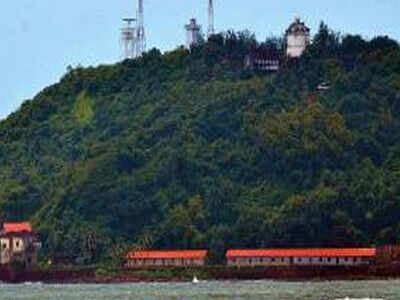
PANAJI: Ongoing restoration work at Goa’s ambitious new museum at the former central jail, Aguada facing the Arabian Sea has irked heritage lovers who allege that the Portuguese-era structure will lose its heritage character and history.
The project has secured a grant of Rs25 crore from the central government to turn the Aguada jail into a world class tourist spot. While heritage lovers and freedom fighters are keenly awaiting its completion, some are unhappy with the conservation methods adopted for the project.
Controversy first broke out over the digging of the green hillside for parking space and stakeholders are now upset at the PVC roof installed, replacing the quaint Mangalore-tiled roof. “This is a prestigious restoration project. Everything has to be kept true to the original structure, and should not be altered for convenience,” Heta Pandit, chairperson of Goa heritage action group (GHAG) said.
A meeting on July 14, 2016 between the project promoters’- Goa tourism development corporation (GTDC), local MLA Michael Lobo, Prajal Sakhardande of GHAG, representatives from Candolim accepted a few proposals, like retaining the Mangalore-tiled roof and adding more Goan elements.
GTDC had involved stakeholders, including freedom fighters during a site visit last year. “All decisions taken and plans made (at the July 2016 meeting) seemed to be perfect. Suddenly, we now find that the plans have changed,” Pandit said.
But GTDC officials said that strictly adhering to conservation parameters is an uphill task. High velocity winds and severe weather conditions at the site expose the roof and structures to much damage.
“Looking at the site from a heritage point of view is easy, but structural conservation here is a big challenge. The changes are needed to raise infrastructure of international standards and we cannot have frequent repairs messing up the place,” an official said.
GHAG disagrees with this point of view. “GTDC’s own environment impact assessment report has considered these factors and even sea erosion, flora and fauna but the changes have come now. They have even locked the gates and are not allowing us a site visit,” Pandit said.
The main fort barracks were built circa 1604-12 and later extended into more blocks to house prisoners, including freedom fighters during the liberation struggle.
The project has secured a grant of Rs25 crore from the central government to turn the Aguada jail into a world class tourist spot. While heritage lovers and freedom fighters are keenly awaiting its completion, some are unhappy with the conservation methods adopted for the project.
Controversy first broke out over the digging of the green hillside for parking space and stakeholders are now upset at the PVC roof installed, replacing the quaint Mangalore-tiled roof. “This is a prestigious restoration project. Everything has to be kept true to the original structure, and should not be altered for convenience,” Heta Pandit, chairperson of Goa heritage action group (GHAG) said.
A meeting on July 14, 2016 between the project promoters’- Goa tourism development corporation (GTDC), local MLA Michael Lobo, Prajal Sakhardande of GHAG, representatives from Candolim accepted a few proposals, like retaining the Mangalore-tiled roof and adding more Goan elements.
GTDC had involved stakeholders, including freedom fighters during a site visit last year. “All decisions taken and plans made (at the July 2016 meeting) seemed to be perfect. Suddenly, we now find that the plans have changed,” Pandit said.
But GTDC officials said that strictly adhering to conservation parameters is an uphill task. High velocity winds and severe weather conditions at the site expose the roof and structures to much damage.
“Looking at the site from a heritage point of view is easy, but structural conservation here is a big challenge. The changes are needed to raise infrastructure of international standards and we cannot have frequent repairs messing up the place,” an official said.
GHAG disagrees with this point of view. “GTDC’s own environment impact assessment report has considered these factors and even sea erosion, flora and fauna but the changes have come now. They have even locked the gates and are not allowing us a site visit,” Pandit said.
The main fort barracks were built circa 1604-12 and later extended into more blocks to house prisoners, including freedom fighters during the liberation struggle.

Coronavirus outbreak
Trending Topics
LATEST VIDEOS
City
 Drug link in SSR case: My son wrongly framed, there are bigger names involved, says father of the accused
Drug link in SSR case: My son wrongly framed, there are bigger names involved, says father of the accused  SSR death case: Mumbai Police under lens? Central agencies to probe whether Call Data Records were leaked
SSR death case: Mumbai Police under lens? Central agencies to probe whether Call Data Records were leaked  With a new turn in SSR case, BJP leader Vishwas Sarang demands dope test for actors
With a new turn in SSR case, BJP leader Vishwas Sarang demands dope test for actors  SSR death: Imtiaz Khatri's alleged role in drug mafia-Bollywood nexus needs to be thoroughly probed, says BJP leader Ram Kadam
SSR death: Imtiaz Khatri's alleged role in drug mafia-Bollywood nexus needs to be thoroughly probed, says BJP leader Ram Kadam
More from TOI
Navbharat Times
Featured Today in Travel
Quick Links
Kerala Coronavirus Helpline NumberHaryana Coronavirus Helpline NumberUP Coronavirus Helpline NumberBareilly NewsBhopal NewsCoronavirus in DelhiCoronavirus in HyderabadCoronavirus in IndiaCoronavirus symptomsCoronavirusRajasthan Coronavirus Helpline NumberAditya ThackerayShiv SenaFire in MumbaiAP Coronavirus Helpline NumberArvind KejriwalJammu Kashmir Coronavirus Helpline NumberSrinagar encounter
Get the app



